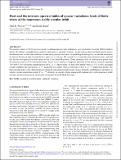Files in this item
Dust and the intrinsic spectral index of quasar variations : hints of finite stress at the innermost stable circular orbit
Item metadata
| dc.contributor.author | Weaver, J | |
| dc.contributor.author | Horne, Keith Douglas | |
| dc.date.accessioned | 2022-01-26T12:30:10Z | |
| dc.date.available | 2022-01-26T12:30:10Z | |
| dc.date.issued | 2022-05 | |
| dc.identifier | 277604028 | |
| dc.identifier | f9f0f1ef-6d22-4906-91b6-fbf359e5473e | |
| dc.identifier | 000770401200003 | |
| dc.identifier | 85127972928 | |
| dc.identifier.citation | Weaver , J & Horne , K D 2022 , ' Dust and the intrinsic spectral index of quasar variations : hints of finite stress at the innermost stable circular orbit ' , Monthly Notices of the Royal Astronomical Society , vol. 512 , no. 1 , pp. 899-916 . https://doi.org/10.1093/mnras/stac248 | en |
| dc.identifier.issn | 0035-8711 | |
| dc.identifier.uri | https://hdl.handle.net/10023/24754 | |
| dc.description | Funding: The Cosmic Dawn Center (DAWN) is funded by the Danish National Research Foundation under grant No. 140. J.W. acknowledges support from the European Research Council (ERC) Consolidator Grant funding scheme (project ConTExt, grant No. 648179), and from the University of St Andrews Undergraduate Research Assistant Scheme. K.H. acknowledges support from STFC grant ST/R000824/1. | en |
| dc.description.abstract | We present a study of 9242 spectroscopically-confirmed quasars with multi-epoch ugriz photometry from the SDSS Southern Survey. By fitting a separable linear model to each quasar's spectral variations, we decompose their five-band spectral energy distributions into variable (disc) and non-variable (host galaxy) components. In modelling the disc spectra, we include attenuation by dust on the line of sight through the host galaxy to its nucleus. We consider five commonly used attenuation laws, and find that the best description is by dust similar to that of the Small Magellanic Cloud, inferring a lack of carbonaceous grains from the relatively weak 2175 Å absorption feature. We go on to construct a composite spectrum for the quasar variations spanning 700 to 8000 Å. By varying the assumed power-law Lv ∝ va spectral slope, we find a best-fit value = 0:71 ± 0:02, excluding at high confidence the canonical Lv ∝ v1/3 prediction for a steady-state accretion disc with a T ∝ r-3/4 temperature profile. The bluer spectral index of the observed quasar variations instead supports the model of Mummery & Balbus in which a steeper temperature profile, T ∝ r-7/8, develops as a result of finite magnetically-induced stress at the innermost stable circular orbit extracting energy and angular momentum from the black hole spin. | |
| dc.format.extent | 3612024 | |
| dc.language.iso | eng | |
| dc.relation.ispartof | Monthly Notices of the Royal Astronomical Society | en |
| dc.subject | Accretion | en |
| dc.subject | Accretion discs | en |
| dc.subject | Quasars: supermassive black holes | en |
| dc.subject | Methods: statistical | en |
| dc.subject | QB Astronomy | en |
| dc.subject | QC Physics | en |
| dc.subject | NDAS | en |
| dc.subject.lcc | QB | en |
| dc.subject.lcc | QC | en |
| dc.title | Dust and the intrinsic spectral index of quasar variations : hints of finite stress at the innermost stable circular orbit | en |
| dc.type | Journal article | en |
| dc.contributor.sponsor | Science & Technology Facilities Council | en |
| dc.contributor.institution | University of St Andrews. St Andrews Centre for Exoplanet Science | en |
| dc.contributor.institution | University of St Andrews. School of Physics and Astronomy | en |
| dc.identifier.doi | https://doi.org/10.1093/mnras/stac248 | |
| dc.description.status | Peer reviewed | en |
| dc.identifier.url | https://arxiv.org/abs/2201.11134 | en |
| dc.identifier.grantnumber | ST/R00824/1 | en |
This item appears in the following Collection(s)
Items in the St Andrews Research Repository are protected by copyright, with all rights reserved, unless otherwise indicated.

